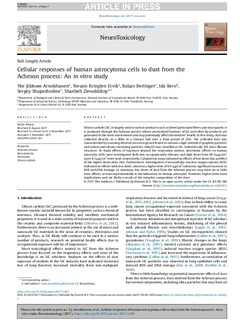| dc.description.abstract | Silicon carbide (SiC) is largely used in various products such as diesel particulate filters and solar panels. It is produced through the Acheson process where aerosolized fractions of SiC and other by-products are generated in the work environment and may potentially affect the workers’ health. In this study, dust was collected directly on a filter in a furnace hall over a time period of 24 h. The collected dust was characterized by scanning electron microscopy and found to contain a high content of graphite particles, and carbon and silicon containing particles. Only 6% was classified as SiC, whereof only 10% had a fibrous structure. To study effects of exposure beyond the respiratory system, neurotoxic effects on human astrocytic cells, were investigated. Both low, occupationally relevant, and high doses from 9E-6 mg/cm2 up to 4.5 mg/cm2were used, respectively. Cytotoxicity assay indicated no effects of low doses but an effect of the higher doses after 24 h. Furthermore, investigation of intracellular reactive oxygen species (ROS) indicated no effects with low doses, whereas a higher dose of 0.9 mg/cm2 induced a significant increase in ROS and DNA damage. In summary, low doses of dust from the Acheson process may exert no or little toxic effects, at least experimentally in the laboratory on human astrocytes. However, higher doses have implications and are likely a result of the complex composition of the dust. © 2017 The Author(s). Published by Elsevier B.V. This is an open access article under the CC BY-NC-ND | |
